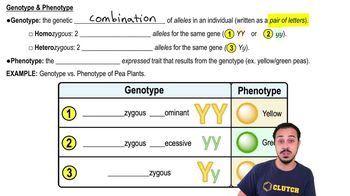An adaptation is a trait of an organism that increases . a. its fitness; b. its ability to survive and replicate; c. in frequency in a population over many generations; d. A and B are correct; e. A, B, and C are correct
Ivory from elephant tusks is a valuable commodity on the world market. As a result, male African elephants with large tusks have been heavily hunted for the past few centuries. Today, male elephants have significantly shorter tusks at full adulthood than male elephants in the early 1900s. This is an example of . a. diversifying selection; b. stabilizing selection; c. directional selection; d. chance; e. more than one of the above is correct
 Verified step by step guidance
Verified step by step guidance
Verified Solution
Key Concepts
Natural Selection

Directional Selection

Phenotypic Variation

The heritable differences among organisms are a result of . a. differences in their DNA; b. mutation; c. differences in alleles; d. A and B are correct; e. A, B, and C are correct
Since the modern synthesis, the technical definition of evolution is a change in in a over the course of generations. a. traits, species; b, allele frequency, population; c. natural selection, natural environment; d. adaptations, single organism; e. fitness, population
Antibiotic resistance is becoming common among organisms that cause a variety of human diseases. All of the following strategies help reduce the risk of antibiotic resistance evolving in a susceptible bacterial population except . a. using antibiotics only when appropriate, for bacterial infections that are not clearing up naturally; b. using the drugs as directed, taking all the antibiotic over the course of days prescribed; c. using more than one antibiotic at a time for difficult-to-treat organisms; d. preventing natural selection by reducing the amount of evolution the organisms can perform; e. reducing the use of antibiotics in non–health-care settings, such as agriculture
